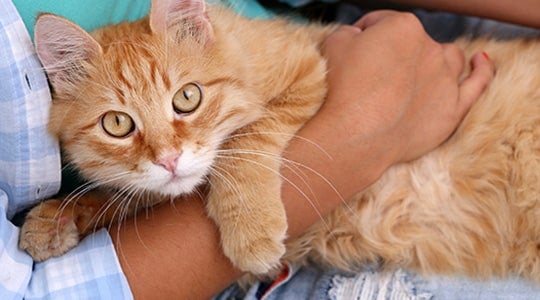

Knowing your cat needs a change in their diet is one thing, but knowing how to make that change is something else! Cats are creatures of habit, so it’s not uncommon for them to prefer their current food to anything new. Change disrupts their routine, which can impact their behavior and their digestion.
Thankfully, when the time has come to change your cat’s diet, a little planning and preparation goes a long way toward making the transition easier for them (and for you).
The following tips will help you change your cat’s diet and successfully transition your cat to a new food:
There are lots of reasons to consider changing your cat’s food — maybe you have a new kitten to wean, a kitten who’s all grown up now or an adult cat entering their senior years. In addition to normal aging, advice from the vet is a common reason to change what you’re feeding your cat. Cats that need help reducing their weight or managing excessive hairballs might need the support of a new food designed with those needs in mind. Whatever your reason for changing your cat’s diet, make sure the new food will suit their needs. That way you only have to make the transition once, and can avoid upsetting their stomach by changing the routine too often.
Going slow is paws down the most successful way to ease your cat into a different diet. Start by mixing 25% new food with 75% familiar food. Slowly change the proportions over the next three days or so by gradually increasing the amount of new food and decreasing the amount of their familiar food. Think of it as a kind of weaning — at the end of this process, you should be feeding (and your cat should be eating) just the new food.
Your cat may choose to eat only the familiar food, or not eat at all … at first. But a healthy cat can miss meals for a day or two without causing health problems. Slow, steady and consistent wins this race!
How would you feel if someone tried to force you to eat strange food you didn’t want?
Aggressively dumping the new food into your cat’s dish and declaring that your cat had better eat it might inspire your cat to do anything besides eat!
A little gentleness in your approach goes a long way. Try using a pleasant tone of voice and encouraging your cat to taste the new food. Even if they don’t go for it at first, a gentle approach still goes over much better than an aggressive one.
Cats train us as much as we train them. Giving in to their demands reinforces that their refusal to eat the new food is acceptable, which makes transitioning to the new diet even more challenging in the long run.
So don’t give up! Don’t be tempted to revert back to your cat’s familiar foods, and don’t give your cat treats or table scraps during the initial three-day period.
This is the toughest dietary transition of them all, but there are a few ways to make the process easier. If your cat resists eating dry food for more than a few meals, try mixing a little warm water with it and maybe even warming the moistened food in the microwave for a few seconds.
If you mix dry food with water, remember to discard any uneaten leftovers after 20 minutes to prevent spoilage. (The same rule applies for wet food.) After your cat is used to the moistened dry food, you can gradually transition to serving the same food dry.
Changing your cat’s diet is sometimes necessary to help them live a happy, healthy life. The process of switching what, how or how often you feed your cat can be a little bumpy, but you can do it! By going slowly, staying patient and encouraging, sticking to the plan and making the transition as easy as possible, you’ll be giving your cat what they need and helping them adjust as comfortably as possible.


Introducing a new cat into your home and life is a rewarding and fulfilling decision, one that requires some thought before you head to the shelter. So what should you consider before adopting a cat? Follow our tips to prepare for the best.
First, let’s explore some of the commitments you’ll need to make to ensure your new cat is content (and that you are, too!).
Make sure your home is cat-safe by eliminating or hiding away anything that could harm or poison your newbie. This includes:
You’ll need a cat bed or hideout, toys, scratching mats, a cat tree or climbing tower, food and water bowls, litter and boxes, and, of course, well-balanced, nutritious cat food. IAMS™ provides a wide range of tailored, nutritional cat food to promote the health of your new cat.
Plan to budget for an annual exam (older cats or those with special conditions may need more frequent visits), medication and parasite preventives. It’s smart to save for emergency care, too.
Providing daily play and exercise opportunities can keep your cat physically and psychologically healthy, and help strengthen your bond. Toys, feather wands and cat trees should be part of your regular rotation! And believe it or not, many cats can be trained to walk on a leash.
Not all cats are solitary or antisocial; however, they can become this way if they aren’t introduced properly to new experiences. Strange sounds, smells and even appliances in your home might make a new cat anxious, as can other family members and pets (more on this later). So be sure to help your new cat get accustomed to unfamiliar people, places and things, and reward and praise them when doing so.
Make sure you have the necessary box, scoop and other supplies to keep things tidy. If you have a multiple-cat household, provide one box per cat, plus one additional box, to help quell territorial issues.
Keep in mind that cats often live into their teens and maybe even a second decade if you’re lucky. Know that you’re adopting a true family member for the extent of their lifetime.
A cat match made in heaven starts by asking some questions about yourself.
If you are not home regularly or gone for extended amounts of time, a cat’s independent nature can be a great fit. If your life includes other people or pets, make sure their behaviors, personalities and lifestyles suit having a cat family member — both for their sake and the cat’s. Allergies can be a dealbreaker, so take note of anyone in your home with cat allergies and their or your willingness to take allergy medication, vacuum constantly and groom the cat regularly to alleviate symptoms.
Your home should also have the space for play and exercise and shouldn’t harbor anything dangerous to your cat.
Cats offer a variety of distinctive personality types, ranging from puppy-like cuddliness to feigned disinterest. Some cats are constantly on the go, exploring and poking into this and that, while others are certified nap ninjas. Vocally, they can be chatty catties or more taciturn souls. In short, you have a wide spectrum of personality types to choose from — which is what makes cats such fascinating and easy-to-love pets.
Kittens will need a lot of attention, direction and a fair amount of patience. Their size, energy and inquisitive nature means you’ll need to supervise them closely.
Adult cats often will settle more quickly into a routine once introduced to their new home. An older or senior adult cat may be even more comfortable interacting with children and furniture. And providing a real home for a cat in their golden years is a rewarding and noble gesture you can feel good about.
All cats shed. This will affect anyone with allergies and could also cause health issues for your cat, like hairballs or matting. Long-haired cats need to be brushed more regularly, and not all cats love this, so you may have to train yours to sit through this daily ritual.
There are several reasons adopting a cat from a shelter or rescue organization is preferable to buying. More effort goes into matchmaking when you adopt, because shelters and rescues generally have more information about their cats. Plus, adopting your cat from a shelter or a rescue actually helps two cats: the one you adopt and the homeless cat who takes your cat’s place.
In contrast, buying can be much more expensive than adopting, and the practice encourages cat mills and increases the number of pets who need homes.
At shelters you can often visit with more than one cat and breed. The screening process can be easier (many shelters allow you to take a cat home that day), and adoption fees can be lower than at a rescue. However, the vet services might not cover all that your cat needs.
Rescues have some advantages over shelters. They often know more about candidate cats because they may be placed in foster homes and even trained for a home. So you could adopt a cat that is already litterbox trained, socialized with other pets and with kids, trained to keep off furniture, etc.
Depending on the rescue’s screening process, you might have to make an appointment to see one cat at a time. While the screening might take longer, it’s designed to match you to the right cat. Adoption fees might be a little higher with a rescue, but they often cover more vet care, too.
While rescues and shelters have similar adoption processes, they do vary depending on the organization. But you can count on these basic steps:
Make sure to have a valid ID to verify age (most organizations require adopters be adults) and address. You might also need references, so it’s a good idea to email or call ahead of time and ask about the application and overall adoption process.
Some of the cat adoption questions you might be asked include:
They might also ask questions about your health, occupation and personal life to help match the right cat to the right parent.
A home and family meet-and-greet might be required to see how everyone, including other pets, gets along with your prospective new cat. And the organization will want to ensure your residence will be a comfortable and safe home.
As we mentioned, cat adoption costs can vary, with rescues often being higher than shelters. Fortunately, the adoption fee will take care of basic veterinary services you will need anyway, including vaccinations, spaying or neutering, and microchipping.
Adopting a new cat isn’t just rewarding — it can be life-changing. Taking stock of the commitments of cat ownership, and taking the time to find your perfect feline match, will help set you both up for years of joy.